It seems to be traditional for people to write a blog post that summaries their Oracle Open World (OOW) experience. Well here is my attempt and it really only touches on a fraction of what I did at OOW, which was one of busiest OOWs I've experienced.
It all began back on Wednesday 21st October when I began my journey. Yes that is 9 days ago, a long long 9 days ago. I will be glad to get to home.
The first 2 days here in San Francisco was down at Oracle HQ were the traditional Oracle ACE Directors briefings are held. I'm one of the small (but growing) number of ACEDs and it is an honour he take part in the programme. The ACE Director briefings are 2 days of packed (did I say they are packed) full on talks by the leading VPs, SVPs, EVPs and especially Thomas Kurian. Yes we had Thomas Kurian come into talk to us for 60-90 minutes of pure gold. We get told all the things that Oracle is going to release or announce at OOW and for the next few months and beyond. Some of things that I was particularly interested in was the 12.2 database stuff.
Unfortunately we are under NDA for all of the stuff we were told, until Oracle announce it themselves.
On the Thursday night a few of us meet up with Bryn Llewellyn (the god father of PL/SQL) for a meal. Here is a photo to prove it. It was a lively dinner with some "interesting" discussions.
On the Friday we all transferred hotels into a hotel beside Union Square.
We had the Saturday free, and I'm struggling to remember what I actually did. But it did consist of going out and about around San Francisco. Later that evening there was a meet up arranged by "That" Jeff Smyth in a local bar.
Sunday began with me walking across (and back) the Golden Gate Bridge with a few other ACEDs and ACEs.
The rest of the Sunday was spent at the User Groups Forum. I was giving 2 presentations. The first presentation was part of the "Another 12 things about Oracle 12c". For this session there was 15 presenters and we each had 7 minutes to talk about a topic. Mine was on Oracle R Enterprise. It was an almost full room, which was great.
Then I had my second presentation right afterwards and for that we had a full room. I was co-presenting with Tony Heljula and we were talking about some of the projects we have done using Oracle Advanced Analytics.
After that my conference duties were done and I got to enjoy the rest of the conference.
Monday and Tuesday were a bit mental for me. I was basically in sessions from 8am until 6pm without a break. There was lots of really good topics, but unfortunately there was a couple presentations that were total rubbish. Where the title and abstract had no relevance to what was covered in the presentation, and even the presentation was rubbish. There was only a couple of these.
Wednesday was the same as Monday and Tuesday but this time I had time for lunch.
As usual the evenings are taken up with lots of socials and although I had great plans to go to lots of them, I failed and only got to one or two each evening.
On Wednesday night we ended up out at Treasure Island to be entertained by Elton John and Becks, and then back into Union Square for another social.
Thursday was very quiet and as things started to wind down at OOW finishing up at 3pm. A few of us went down to Fishermans Wharf and Pier39 for a wander around and a meal. Here are the some photos from the restaurant.
Friday has finally arrived and it is time to go home. OTN are very generous and put on a limo for the ACEDs to bring us out to the airport.
As always there are lots of people to thank but I won't start naming names here as I'm sure I will forget someone. But I do want to thank all the gang in OTN that look after the Oracle ACE programme. You really look after us, not just at OOW, but all year round. It is with your support that I get to go to wonderful conferences and to OOW.



















